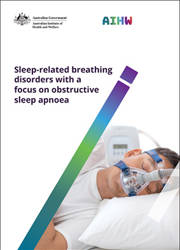Summary
Sleep-related breathing disorders, in particular obstructive sleep apnoea (OSA), can have detrimental effects on sleep quality and health. Effective diagnosis and successful treatment can reduce symptoms and improve the quality of life of patients. In Australia, eligible patients can access Medicare-funded sleep study services to clinically assess and diagnose sleep disorders, including OSA.
Using data from the Medicare Benefits Schedule and the National Hospital Morbidity Database, this report provides a snapshot of Australian health system activity on services related to the diagnosis, treatment and management of sleep disorders, with a focus on OSA. These data are supplemented with data from the National Mortality Database on deaths associated with OSA.
Around 133,000 patients received a Medicare diagnostic sleep study in 2019
This represents a rate of 6.7 per 1,000 Australians aged 18 and over. Claiming rates were higher for home-based sleep studies (4.7 per 1,000 population) than laboratory sleep studies (2.1 per 1,000). For both types of studies, rates were higher for men (8.3 per 1,000 population) than women (5.2 per 1,000). Laboratory studies were most common among patients aged 65–74, while home-based studies were most common for patients aged 45–64.
Claiming of diagnostic sleep studies varied by state and territory, remoteness and socioeconomic
area of residence
Home-based sleep studies were more common than laboratory sleep studies in all states and territories. Claims were higher for laboratory studies in Major cities and for home-based studies in Inner regional areas. Rates were higher for laboratory studies in the highest socioeconomic areas.
More than 21,100 patients received a Medicare treatment management sleep study service in 2019
This represents a rate of 1.0 per 1,000 Australians aged 18 and over. Most claims were for a treatment initiation sleep study (0.8 per 1,000 population). The rate of claiming was higher for men (1.0 per 1,000 population) than women (0.6 per 1,000), and for people aged 65–74 (1.8 per 1,000). Claiming rates were highest in Queensland (1.2 per 1,000 population) and in Outer regional areas.
Most patients accessed other Medicare services before or after their sleep study
Between 93% and 98% of patients visited a general practitioner in the 6 months before or after their sleep study. More laboratory sleep study patients visited a specialist in this period (85–89%) than home-based study patients (56–63%).
A respiratory and sleep medicine physician was the specialist most commonly visited by both laboratory and home-based sleep study patients.
There were 39,472 hospitalisations with a principal diagnosis of OSA in 2018–19
A further 18,870 hospitalisations had an additional diagnosis of OSA. Hospitalisation rates with OSA as the principal diagnosis were higher for men (254 per 100,000 population) than women (133 per 100,000). There were 32,394 hospitalisations with procedures specifically for OSA. Of these, 95% were for polysomnography—a sleep study used to diagnose sleep disorders. The rest were surgical procedures to treat OSA.
1. Introduction
- What are sleep-related breathing disorders?
- What is obstructive sleep apnoea?
- How are sleep-related breathing disorders and OSA diagnosed?
- How are sleep-related breathing disorders and OSA managed?
- Purpose of this report
2. Use of MBS sleep studies, people with sleep-related breathing disorders and OSA
- Use of MBS diagnostic study
- Comparing claiming patterns by patients using laboratory and home-based sleep studies
- Use of MBS treatment management study
- Treatment initiation sleep study (MBS item 12204)
- Treatment effectiveness sleep study (MBS item 12205)
- Further investigative sleep study (MBS item 12207)
- Use of general practitioner/ specialist/ allied health services by sleep study patients: a cohort analysis
- Laboratory sleep study cohort
- Home-based sleep study cohort
- Comparing other services used by laboratory and home-based sleep study patients
- Hospitalisation among people with OSA
- Hospitalisations
- Procedures
- Other health conditions (additional diagnoses) in OSA hospitalisations
- How many people die from OSA?
3. Challenges in collecting and reporting data on sleep-related breathing disorders
Appendix: Distribution of MBS sleep study services by SA3
End matter: Acknowledgements, Abbreviations, Glossary, References



